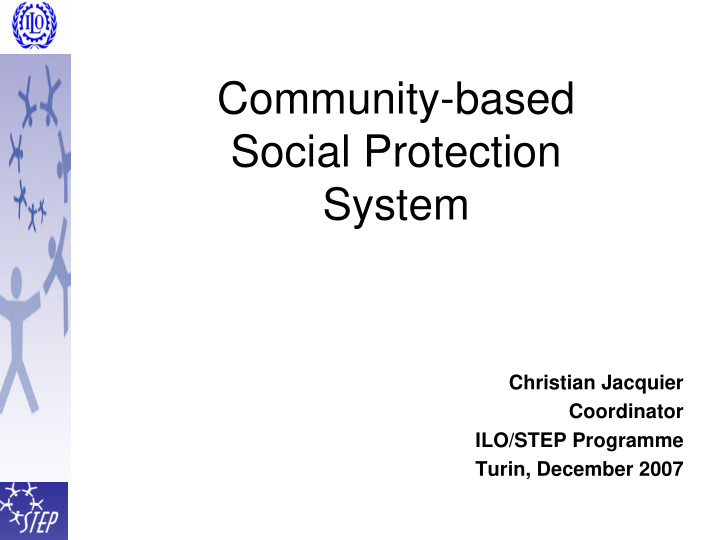



Community-based Social Protection System Christian Jacquier Coordinator ILO/STEP Programme Turin, December 2007
Community-based Social Protection System 1. Global Phenomenon 2. Origins and causes phenomenon 3. Characteristics 4. Sectoriel Organization 5. Comparative Advantages 6. Limits 7. Linked (articulated) Systems 8. Agenda & International Consensus
Global Phenomenon • Africa • Asia • Latin America • Europe, Japan, North America • Global Inventory: universal phenomenon, with a significant increase
Origin and causes • Deficiency of Social Security Cover • Deficiency of the Offer • State Deficiency • Dysfunctions of National Systems: lack of funds, inefficiencies, lack of solidarity & equity • Local initiatives of the civil society • Reality and importance of needs to have a Social Protection • Conceptual Pertinence
Characteristics • Shared characteristics – Cover of poor and excluded people – low « insurance premium » – Development of customized package (Composition du paquet adapté) – Procedures adapted – reduction of transaction fees – increase in value of « social capital » Diversity of: • Stakeholders • Mechanisms • Covered risks • Names • Legal status • Size • Governance • Funding
Sectoriel Organization • Mutual sector • Cooperative sector • Social Security • Micro-finance • Networks of associations • Micro-insurance • Regulators • Donors • Networks of universities
COMPARATIVE ADVANTAGES • Participation & democratic governance • Proximity of the beneficiaries • Empowerment of excluded people: counter-power • Increase of dignity • Specific needs and local characteristics taken into account • Increased value of local resources and “social capital” • Reduction of transaction fees • Reduction of frauds and insurance risks • Strengthening of responsibilities • Improvement of prevention, education, and of health promotion • Identification of the poorest as well as of local solidarity • Develop prepayment and increase access for the excluded • Decrease direct payments
LIMITS • Lack of funding: low contribution • Limited insurance package • No national solidarity: problem of equity • Exclusion of the poorest • Voluntary joining • Low penetration rate: 10 to 20% • Marketing complexity • Importance of non renewal • Insufficient risk pulling • Financial weakness • Insufficient managerial capacities • Lack of bargaining power • Insufficient size But it is not inevitable…
LINKED SYSTEMS • Plurality of stakeholders and mechanisms : – State, local governments, service providers, SS institution, micro- assurances/mutual, civil society, donors, social partners, TPA, private sector,… • Potential Complementarities and synergies • Subsidiarity concept • New concept: “linked systems” • India, China, Philippines, Laos, Rwanda, Senegal, Ghana, Colombia, Uruguay… • Study of the international Alliance (ILO/STEP, ISSA , AIM) • First Social Security World Forum Moscow (Sept 2007) • Field experimentation
Spread significantly social protection through micro-insurance Articulated System in Colombia FI NANCEMENT Régime MULTI PLE & REDI STRI BUTI ON subventionné en Colombie mis en place en 1993 État Régime Paquet unique défini contributif 70% du par l’Etat (les acteurs financement n’ont pas la liberté de proposer n’importe Transfert de 1/12 Assurance Assurance quel paquet) Régime Contributions des contributions = sociale sociale = 12% salaire 30% du financement subventionné Financé et régulé par Employeurs l’État, gestion confiée à 18,5 millions de & travailleurs un ensemble d’acteurs personnes couvertes de diverses natures 15 millions de (les mutuelles ont 60% personnes couvertes Couverture: 30% en 1993, du marché) 80% en 2005, objectif 100% en 2009
Spread significantly social protection through micro-insurance Articulated systems in India Cotisations Institutions Système national Taxes État assurés, financières, de sécurité sociale (cess) central employeurs Secteur privé Cible : 300 millions BPL Paquet garanti : vieillesse, santé, (TATA) maternité, décès, invalidité Fonds Proposition de modèles possibles d’organisation à partir de l’analyse de FI NANCEMENT la diversité des expériences en Inde MULTI PLE ORGANI SATI ON Administration au Représentation / niveau central & GOUVERNANCE participation: gouvernement, employeurs, travailleurs, Administration Administration Administration société civile Etat 1 Etat 2 Etat 3 Modèles possibles TPA d’organisation intégrant TPA différents acteurs (ONGs, Assureur assureurs, partenaires Trust ONG sociaux, coopératives …) ONG MFI Coopérative Délégation éventuelle de la gestion à des TPAs
Spread significantly social protection through micro-insurance Articulated Systems in Senegal Filières, Solidarité État coopératives, internationale employeurs GESTI ON DELEGUEE FI NANCEMENT MULTI PLE Centre de gestion partagé Assurés Fédération ou Formations sanitaires structure centrale � � � � � État / min � � � � � � � � �� de la santé � � � � � � � � CONTRACTUALI SATI ON Réseau local ORGANI SATI ON & de proximité GOUVERNANCE
AGENDA and international CONSENSUS • Social Protection on top of the international Agenda • Human rights, public goods, poverty reduction, profitable investment • SP Coverage extension as a top priority • Principle of Solidarity at national and international levels • Universal coverage • Realism and relevance of the basic package • Consistency of national systems • Organizing and solvability of the demand • Articulated systems • Knowledge management
Recommend
More recommend